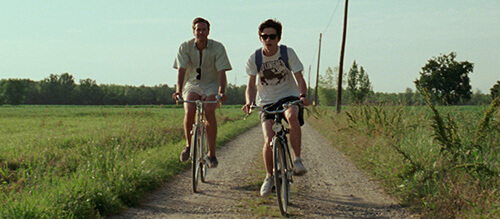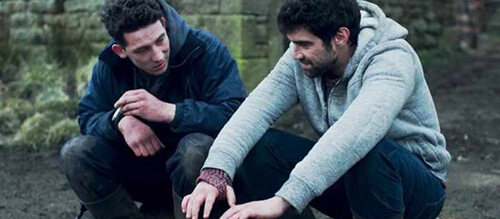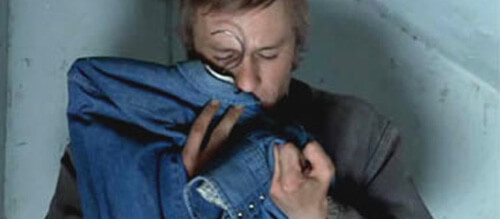Fabric Love: Costume in Gay Cinema
This article was written exclusively for The Film Magazine by Annice White.
I was watching Call Me By Your Name for the 3rd (14th) time when I began to think about the importance of clothing in cinema; how clothing is more than just a formation of identities and markers of relationships. It got me thinking of how Stella Bruzzi suggests that ‘clothing is central to film. Clothes are not mere accessories, but key elements in the construction of cinematic identities’.
This notion is arguably no truer than in cinema that explores male-male romance narratives.
Firstly (and of course this can be said of all cinema) clothing is used as a signpost of a character’s personality and identity. Secondly, it is often used to emphasise the romance and union of those characters, therefore coming to represent their relationship. Finally, and in my opinion what sets these narratives apart, is that clothing is a key element used to show the end of the fantasy world in which the romance primarily takes place. Moving forward in this piece, I’m going to look to explore the ways in which costume is used is used in Call Me By Your Name (CMBYN), God’s Own Country and Brokeback Mountain.
The clothing in CMBYN is key [don’t click away this isn’t a rant about how it should have won the Best Costume Oscar, though it should have done]. The film was arguably the style bible of summer 2018, whether you are an Elio or an Oliver.
On the base level, clothing is used to present the differences between the characters. Elio is youthful in Demin shorts and band t-shirts, or shirtless to show his boyish figure and colourful (fun) swimwear. Oliver is grown up and structured, although his shirts are oversized they do not seek to make him small, more to grow his presence in the frame and emphasise his stature over Elio.
But this is not the case in all male-male romance cinema.
In both God’s Own Country and Brokeback Mountain, clothing isn’t used to overtly form character identities. A character’s costume is often functional and representative of their occupation – think cowboy hats and sensible layers. This is not to suggest the clothing is not important; care is still taken, with Johnny’s grandmother carefully and lovingly ironing her grandson’s clothing in God’s Own Country to emphasise this. Arguably, this could also be indicative of the social divide between the films, CMBYN vs God’s Own Country and Brokeback Mountain (but that’s another article for another day).
The second use of clothing in cinema is to emphasise the romance within the narrative. It is an image we are all familiar with… a woman wearing her lover’s clothing – men often give a girl their jackets because men clearly just so strong and warm. Another image is that of the ‘Sexy Shirt Switch’, in which a woman after a night of passion wears the shirt of the man that she has just slept with. This is often used to signify that intercourse has happened and that the characters have now taken their relationship to that level (also note that the shirt is always big on her, because god forbid she be bigger than her partner). This doesn’t work the other way around; a man does not wear his girlfriend’s clothing unless it’s played for laughs. Wearing your boyfriend’s clothing is often a sign of dominance and ownership, think Letterman jackets. But how does this particular trope play out when there is no clear gender divide?
Allow me to speak in stereotypes for a moment…
The clothing will be similar and will not be a clear marker that shouts to us (the audiences of such films) “these are not my clothes!” This idea is more noticeable in God’s Own Country and Brokeback Mountain, as previously suggested. The characters’ clothing does not create barriers between them nor signify such barriers being crossed. One character’s clothing does not present dominance over another. However, in CMBYN, dominance can be read through clothing. Elio takes a submissive role within the relationship. Oliver is not only older, but larger and taller. His clothing quite literally takes over Elio’s body – think of the scene in which Elio puts his head in Oliver’s shorts. Oliver’s clothes envelope Elio.
Further to this notion of dominance, all three movies feature scenes or sequences in which the line between clothing and (therefore) characters are blurred. In God’s Own Country, Johnny’s grandmother returns home from the hospital to find a pile of unwashed clothing mounted on his floor. This jumble signifies the unity of the central most romance, which the audience have just witnessed; the merging punctuated with a used condom. It could be read that Johnny’s grandmother doesn’t know that these are both Johnny and Gheorghe’s as there is no element of shock in her tidying up, but it could also signify her acceptance of their budding romance and bleak resignation to her role as an archetypal mother figure. Another example of this is when Gheorghe leaves and Johnny wears his jumper, putting his thumb in the hole where Gheorghe’s had been. In Brokeback Mountain, Ennis wears Jack’s shirt instead of his own, placing them together. ‘The pair like two skins, one inside the other, two in one’ (from the short story). This merging is most clear in CMBYN when, before Elio and Oliver separate, they are both wearing Oliver’s previously established signature button down shirts. Oliver in green and Elio in Blue (readers of the novel will know this shirt as “billowy”). This is importantly the same shirt that Oliver arrives to the house in. In this final scene at the station, they become each other, or, more accurately, Elio becomes Oliver. Their merging is a key feature of their narrative and their romance and the wardrobe of each character and the development of such plays a key role in establishing this, if only on a subconscious level..
As often in male/male romance narratives (and, to some extent, many romance narratives, because god forbid people should be happy), there must be an end to the fantasy world in which the central couple temporarily occupy. In terms of God’s Own Country, Gheorghe and Johnny are unable to live in a fantasy land, their ‘escape’ and fantasy therefore shortly lived. Johnny’s father’s second stroke cuts their romance short and the reality of their lives and responsibilities hit home. In addition to their clothes being mixed on the floor, further wardrobe is stripped away in the few scenes of their short domestic life together – they are shown to bathe and lay naked with one another. In a similar way to mixed clothing, their lack of clothing is a sign of their equality. In CMBYN, Oliver has returned to America and Elio has returned to his family. It is interesting to note that Elio returns to his old style once home. In the most heart-breaking scene in recent cinema, Elio is back in short shorts and t shirts. Billowy is for when he is with (and therefore is) Oliver. In the final scene, when Elio learns that Oliver is getting married, his style is a mix of each of them; a more grown-up Elio featuring an oversized button-up shirt, but one that is noticeably patterned. It’s a perfect signifier to his developed maturity which has certainly been influenced by Oliver. Brokeback Mountain offers a similarly tragic ending: Ennis is physically and metamorphically alone, living with his memory and one of Jack’s shirts.
A lover’s shirt acts a memento in all three films – Billowy in CMBYN, Jack’s shirt for Ennis in Brokeback Mountain. However, God’s Own Country plays with this trope of an unhappy departure to instead offer something arguably less tragic. Johnny returns Gheorghe’s jumper back to him ‘on a coach and everything’. God’s Own Country gives us all the elements of the tragic narrative to offer a ‘happy’ ending, should you choose to be an optimist at least.
It is clear, then, that clothing is used in cinema as a signpost for a character’s identity, and this is certainly the case in male-male romance movies, despite how its use can often be less clear, or signified in different ways. Clothing creates a space in which romance can be signposted and explored, helping to develop our understanding of the relationship between any two characters and their relationship to the wider world. But the most important piece of this puzzle is that their fantasy worlds must come to an end, whether it be through tragedy (separation or death) or unity. After all, it is not a film about gay love without someone getting too attached to a piece of the other’s clothing.
Written by Annice White
Make sure to support Annice by following her on Twitter – @Anniceswhite1
[DISPLAY_ULTIMATE_SOCIAL_ICONS]




